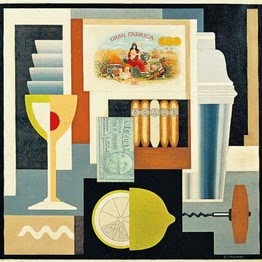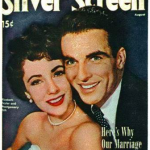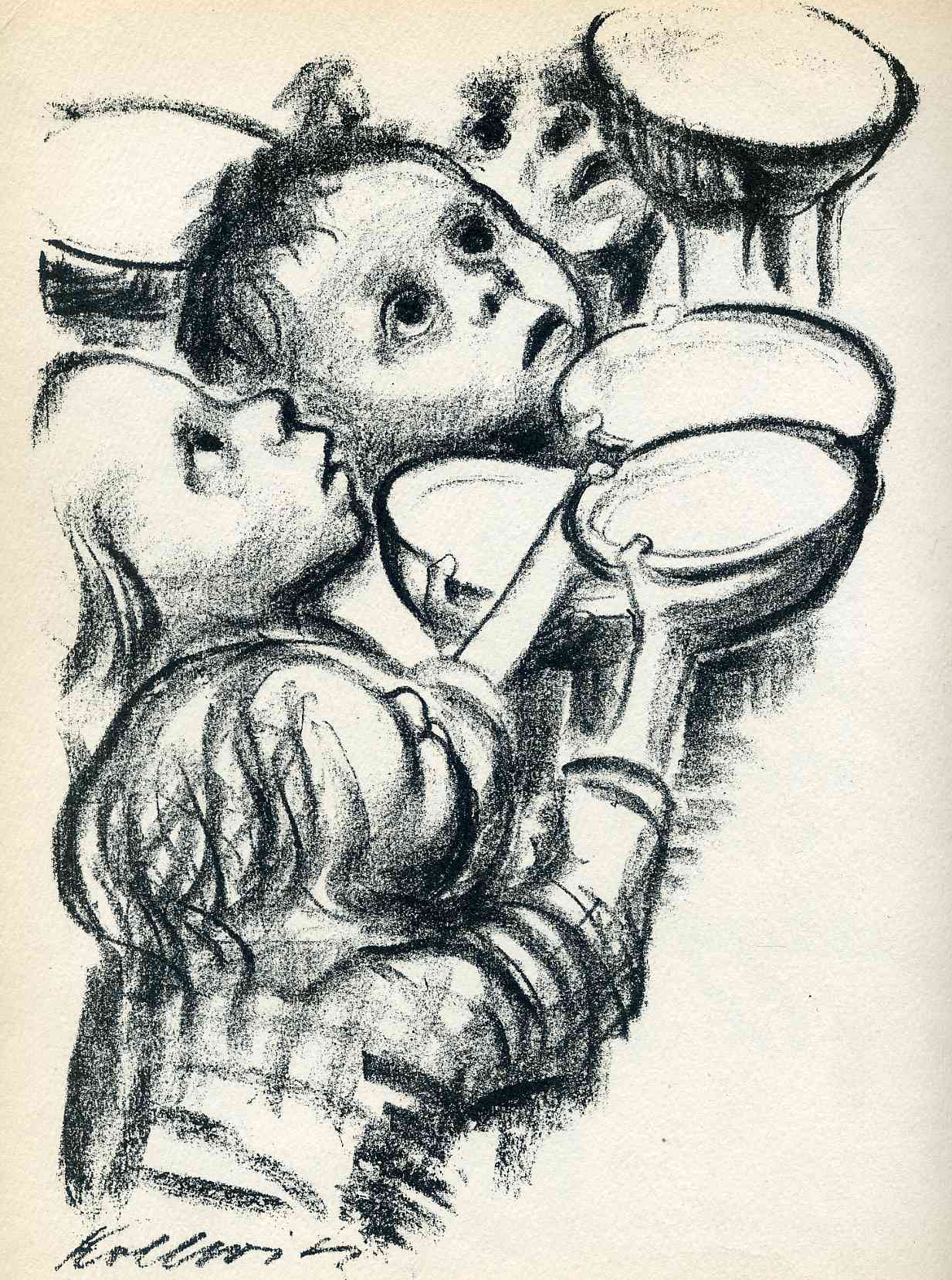Rembrandt’s preliminary sketch for The Night Watch (1642) has been discovered beneath the surface of the paint, using the latest scientific techniques. Conservators at the Rijksmuseum have also determined the worrying extent of a rippling deformation of the canvas, which was caused when the picture was moved during building work in 2003-13. This will now require urgent treatment.
Deems Taylor
The Night Watch, the most important painting from the Netherlands, has been investigated by a 30-strong team at the Amsterdam museum during the past two and a half years.
The discovery of Rembrandt’s original painted sketch was announced this morning at the Rijksmuseum.
Read the rest.
gallerynews.com
Night Watch Sketch Discovered in Holland
December 8, 2021Jeff Koons: Lost in America
November 30, 2021 “The exhibition title is borrowed from a 1985 American satirical comedy film of the same name directed by Albert Brooks, about a 1980s yuppie couple in Los Angeles who are disgruntled by their bourgeois lifestyle. Koons wants viewers to draw their own interpretations of that title, as well as the intention or meaning of the works.”
“The exhibition title is borrowed from a 1985 American satirical comedy film of the same name directed by Albert Brooks, about a 1980s yuppie couple in Los Angeles who are disgruntled by their bourgeois lifestyle. Koons wants viewers to draw their own interpretations of that title, as well as the intention or meaning of the works.”
Is Dog Food Bad for Children?
October 10, 2021ASK THE DOCTOR
with Ferenc Molmar, MD
 Q. Dear Dr. Molmar, We have neighbors who often punish or discipline their children by chaining them up in a dark basement with dishes of dog food and water. It’s canned dog food, I believe, though sometimes they also get kibble. I’ve heard of old people taking a fancy to cat food, which is understandable since that’s often a sort of low-grade tunafish (to judge by the smell), but dog food has me wondering. We were always told not to feed dogs chocolate or garlic because it might kill them, but I’m wondering if perhaps the reverse is also true: don’t feed people Gravy Train because it will make them sick?
Q. Dear Dr. Molmar, We have neighbors who often punish or discipline their children by chaining them up in a dark basement with dishes of dog food and water. It’s canned dog food, I believe, though sometimes they also get kibble. I’ve heard of old people taking a fancy to cat food, which is understandable since that’s often a sort of low-grade tunafish (to judge by the smell), but dog food has me wondering. We were always told not to feed dogs chocolate or garlic because it might kill them, but I’m wondering if perhaps the reverse is also true: don’t feed people Gravy Train because it will make them sick?
Incidentally, these kids do look pretty sick much of the time, all hollow-eyed and tired-looking, at least on those few occasions I’ve seen them out and about. What’s your take on all this?
“CONCERNED NEIGHBOR”

Dr Molmar
A. My dear CONCERNED, I am not a veterinarian but I suspect this is a common question. Dog food and cat food are sort of like paint chips: sooner or later stupid kids will try to eat the stuff. If it were truly toxic, we’d have all these accounts of three-year-olds rushed to Emergency after finishing off the doggie dish. In the old days they put all kinds of offal into dog food (you’ve heard of “meat by-products”), like horse intestines and pig brain, but my guess is the stuff is pretty safe now.
I suppose if the kids are getting fresh water in the water dish they should make it through. But a dank basement will breed mildew and lots of pathogens. If the parents are like neglectful dog owners I’ve seen, the water dish is probably a rusty old pie pan and they only change it every two or three days. So that’s something I’d watch out for. If you’re wondering whether you should get involved and “report them to the authorities” then I recommend holding off. Tales of child abuse are pitiable and unfortunate, but so long as there’s no sex perversion involved you might not want to stir up trouble.
Why London Should Keep the Elgin Marbles (and Why You Should Care)
October 9, 2021Ever since they removed the British Library from the British Museum, the Museum’s two biggest attractions are the Rosetta Stone and the Elgin Marbles. Maybe the Stone and Marbles have always been the biggest attractions these past hundred, two hundred, whatever years. I mean apart from traveling exhibitions of King Tut’s knickknacks and terra-cotta Chinese soldiers, and such like.

Dickens in the Room
Though personally I favored the old Library’s main Reading Room, with its raised circular daïs (famously helmed by Angus Wilson in the 1940s and 50s) and its ghosts of scribblers past (Charles Dickens, Karl Marx, Colin Wilson). I don’t know where I’m going with this, except I want to say it always gets my goat when I see people whining about how London shouldn’t have the Marbles because they really belong to “Greece.” Yeah, right! The Greece of 2500 years ago, maybe. Not the hybridized Balkan-Turk polity that exists today.
If Lord Elgin or whoever it was hadn’t carted them off to England, they’d have gone the way of most ancient Greek treasures, with their heads and arms cut off, or full of bullet holes.

Racy Marbles?
In case you don’t know what I’m talking about (a common problem once I get going), the Elgin Marbles are these sculptures that once decorated the cornice, or pediment or whatever it’s called, of the Parthenon. You know, the triangular part that sits on top of the pillars. I’ll try to find a picture. They’re not particularly astounding as sculptures, mind you, but the fact that they really are part of the Parthenon makes them interesting, and accounts for all the tiswas that people get into when they imagine they should be shipped back to Athens, because . . . well, just because.
Here’s a typical miseryguts article along those lines in the Grauniad. How pathetic. “As a Briton I hang my head in shame,” oh boo hoo.

Here we are. Why modern Greeks can’t have nice things. If you want to see what the Parthenon should look like, you have to go to Nashville.
The obvious solution, it seems to me, would be to ship the Parthenon, maybe complete with Acropolis, to London. I wouldn’t be adverse to moving it stateside, maybe Lake Havasu. You know, like London Bridge. But then we have the problem of getting the British Museum to give up the Elgin Marbles, and so we’re back to where we started. Perhaps we could compromise on someplace in between. Legoland maybe.
Another interesting thing about the Marbles is that originally they were painted. Still a little paint left on the Marbles, if you look closely. The Greeks painted their statues, you know. All these modern sculptors—Saint-Gaudens, Rodin, Epstein, Moore—think they’re being really classical with all-white or all-bronze figures. But if they really wanted to do the Praxiteles thing they should splash a nice coat of paint on their work. Then again, maybe they can’t paint, and maybe that’s the real issue.
Anyhow, that’s your art history lesson for the day. For extra credit you can read this really nice detailed history of the Marbles that was recently “published” in ArtNews.
Sotheby’s Tests Out Crypto Sales
May 6, 2021 Sotheby’s, the auction house formerly known as Sotheby Parke Bernet, and before that as Sotheby’s, is testing out art sales with cryptocurrency. Just to see how it goes, they’re starting off with some Banksy crap.
Sotheby’s, the auction house formerly known as Sotheby Parke Bernet, and before that as Sotheby’s, is testing out art sales with cryptocurrency. Just to see how it goes, they’re starting off with some Banksy crap.
Bitcoin and Ethereum seem to be the Coins of the Realm at the moment, but no doubt Dogecoin and Monero will get a look-in if all works out properly.
You can read about it all here:
You Can Buy a Banksy With Bitcoin or Ethereum From Sotheby’s
The street art icon’s “Love is in the Air” will be the first physical artwork sold by an auction house with the option to pay in cryptocurrency.
In the meantime, have you considered buying art from Gallery News? We also take Bitcoin and Ethereum. Right now have secured a supply of Diego Rivera prints, specifically his renowned “Glorious Victory,” complete with lascivious caricatures of the Dulles brothers, anti-communist guerrillas and Ike Eisenhower drawn on a bomb. It all has something to do with Guatemala in 1954. Look at this beautiful work of art:
 And now, if you send us $20 or more in crypto or PayPal cash (see right rail) we can send you one of these stunning reproductions, postpaid! Our copies measure 11″ x 6″ which makes them suitable for framing. We trimmed a little off the edges, but nothing essential.
And now, if you send us $20 or more in crypto or PayPal cash (see right rail) we can send you one of these stunning reproductions, postpaid! Our copies measure 11″ x 6″ which makes them suitable for framing. We trimmed a little off the edges, but nothing essential.
Be sure to send us your physical mailing address, since these will not fit in our ethernet cable. You can include that when you send us your crypto or (PayPal) cash. For more information, contact our shipping clerk, P J Collins: pjcollins@gallerynews.com.
Random Art Article #1
April 28, 2021A list of the 101 most important painters of the history of Western Painting, from 13th century to 21st century
by theartwolf.com
Although this list stems from a deep study of the painters, their contribution to Western painting, and their influence on later artists; we are aware that objectivity does not exist in Art, so we understand that most readers will not agree 100% with this list. In any case, theartwolf.com assures that this list is only intended as a tribute to painting and the painters who have made it an unforgettable Art
1. PABLO PICASSO (1881-1973) – Picasso is to Art History a giant earthquake with eternal aftermaths. With the possible exception of Michelangelo (who focused his greatest efforts in sculpture and architecture), no other artist . . .
The Whitney Is a Dawg. So Is Hudson Yards.
March 15, 2021
In my life I think I’ve enjoyed exactly two exhibitions at the Whitney Museum, and both were traveling shows for Grant Wood. Otherwise the Whitney was enjoyable mainly for its Permanent Collection, full of familiar figurative paintings by the likes of George Tooker and Edward Hopper and Thomas Hart Benton. Also one or two Gerald Murphy collages, which don’t seem to be on display anymore, according to the website.
 Looking through the list of Events and Exhibitions, I gather that the Whitney currently specializes in a) chaotic smudges, and b) photographs of negroes.
Looking through the list of Events and Exhibitions, I gather that the Whitney currently specializes in a) chaotic smudges, and b) photographs of negroes.
It should be recalled that the primary purpose of the Whitney was never to display or warehouse art, in the manner of the Metropolitan Museum or the Musée d’Orsay. No, the Whitney functioned primarily as a meeting point. Kids would come home from prep school or college for the holidays, and the Whitney Museum at Madison Avenue and 74th Street was a convenient, centrally located venue.
The Met wasn’t any good for that because it was too damn big. With the Whitney, you could just say, we’ll meet at the Calder Circus in the lobby at noon, and nobody got lost.
But that was then. For some reason the Whitney organization decided it had to move to a vast, brutalist-modern box in the Meat Market neighborhood. Because the Meat Market was now Artsy-hip Central, and the new Whitney would be hard by the High Line, the pedestrian promenade that used to be an elevated freight railroad. Perfectly understandable, but as a result the museum is no longer a meeting point. It’s a destination that’s rather difficult to get to even if you’re coming from Chelsea or the Village. (The old Whitney is now a annex of the Met.)
As a colossal mistake, the new Whitney resembles that other showy development on the West Side, the Hudson Yards. A couple of years ago we saw the opening of the world’s biggest and glitziest shopping mall (“The Shops at Hudson Yards”), 7 storeys of upscale chain stores and overpriced restaurants and gin joints. The trouble was, it was difficult to get to, mainly dependent on a new subway terminus that had just opened at 34th Street and 11th Avenue. The neighborhood was historically a dismal spread of warehouses and stables, slaughterhouses and trolley barns. Not a residential neighborhood at all. So even though the Hudson Yards developers were erecting thousands of new apartments and multi-million-dollar condos, the area wouldn’t be an established, stable residential neighborhood for another five or ten years.
And then, before the shopping mall had been open for a year, the Covid-19 lockdown began, and the public had even more reasons to stay away. Retail tenants closed and canceled leases right and left. “Eerily deserted,” said the New York Times. One doesn’t know whether to laugh or cry.
There is an upside to all this, but it’s going to be a long time coming. At the end of a era of overdevelopment and senseless expansion, the weakest members of the herd get sick and die off. Projects go bankrupt, while investors and residents refocus their attention on safe investments in tried-and-true localities. Exactly how this can benefit the Whitney is puzzle, but I wouldn’t be surprised to see the directors attempt to buy their old building back from Met, and unload their crazy Big Box on a Greater Fool. Why not The New School?
Running the Gauntlet; or, The Joys of Contagion
March 10, 2021Hair-salon touts, eye-cream hucksters, and other species of urban vermin.
One of the subtle delights of this past year’s Covid-19 lockdown is that it shooed away the commercial panhandlers who pester you in pedestrian thoroughfares. They used to be particularly thick in the stretch of sidewalk in front of the Time Warner Center at Columbus Circle.
The worst, and most insistent, were the hair-salon racketeers. These touts, generally youngish and male, would approach you and ask you if you got your hair done professionally. You’d say yes, and then the tout would try to persuade you to try out a friend’s new salon, for which you could receive a one-time discount. But to get the discount you’d have to pony up $75—right here and now on the sidewalk.
If you seemed dubious about all this—handing over $75 to a sales rep for a strange hair salon in a distant part of Midtown—he immediately assured you that it was a top-drawer outfit.
“Look! Five stars on Yelp!”—as he flashed his smartphone at you.
 After this happened the first time, I spent the rest of the day pondering what a terrible business model the whole thing was. Forget the $75 and “Five stars on Yelp!” nonsense. Most women simply do not visit new hair salons on a whim or because they’re promised cut-rate service. Generally they stick with a single stylist, whom they loyally follow from salon to salon. Or else, if the stylist suddenly packs up and takes a job in Hollywood, they find someone else in a salon they know well. They’ll do this even even it means paying $250 every month or two. Price is not really a selling point in the hair business. Certainly not a deal-closer when you’re being pressured by a complete stranger at Columbus Circle.
After this happened the first time, I spent the rest of the day pondering what a terrible business model the whole thing was. Forget the $75 and “Five stars on Yelp!” nonsense. Most women simply do not visit new hair salons on a whim or because they’re promised cut-rate service. Generally they stick with a single stylist, whom they loyally follow from salon to salon. Or else, if the stylist suddenly packs up and takes a job in Hollywood, they find someone else in a salon they know well. They’ll do this even even it means paying $250 every month or two. Price is not really a selling point in the hair business. Certainly not a deal-closer when you’re being pressured by a complete stranger at Columbus Circle.
A smoother, older kind of sidewalk hustle may be found in the eye-cream racket. These operators are always Israeli, both male and female, and stand (or rather, stood) in doorways of cosmetic shops on Madison Avenue or the stretch of Broadway just north of Columbus Circle. When they see normal women strolling past—I mean the kind who use moisturizer and makeup—they wave sample packets of eye cream at them.
There’s always something unlikely and exotic about their cream. One popular come-on a few years ago was saying it contained flakes of real gold. And so you took the little foil sachet, and the gang in the doorway immediately implored you to step inside and try some of their other wares. Sometimes they’d even offer you a voucher for a free facial or makeover on some day next week, at some spa you never heard of.
The eye-cream hucksters of Columbus Circle have been shut down, along with their neighbors, the soap girls who would stand out on the sidewalk with their baskets of colored, scented handmade samples. I do wish to say, though: those young ladies outside the soap shop were always cheery, never nagged, and arguably provided an essential service. Sometimes you need to give someone a cheap gift, or they’re doing a Secret Santa thing at your office. What could be a lamer and more inoffensive gift for some random coworker you barely know, than a hunk of pretty, perfumed soap?
Columbus Circle today is not entirely safe for social-distancing shoppers, however. Those young people in badges and hoodies proclaiming dodgy charities, they are once again out in strength, waving their clipboards as you come into view. Legalize Sex Perversion! Children in Cages! Save the Narwhal!
 Forty years ago, the neighborhood was a half-step up from a slum. You had the decaying Huntington Hartford Museum just south of the Circle, and the dismal New York Coliseum to the west, where the Time Warner Center now stands. A faint bit of cheer was injected by a banner on an old gabled building to the north, advertising Jacki Sorensen’s Jazzercise.
Forty years ago, the neighborhood was a half-step up from a slum. You had the decaying Huntington Hartford Museum just south of the Circle, and the dismal New York Coliseum to the west, where the Time Warner Center now stands. A faint bit of cheer was injected by a banner on an old gabled building to the north, advertising Jacki Sorensen’s Jazzercise.
The sidewalk ruffians were different, too. They didn’t promote hair salons or eye cream or Planned Parenthood. They often wore jackets and ties, and tried to chat you up about Henry Kissinger and the dank history of the British Monarchy. For a mere $300 they would let you have a full year’s subscription to the Executive Intelligence Review, the most informative periodical in the world, which was published right around the corner. That’s our founder on the cover, Lyndon LaRouche!
Ask the Family Doctor: Race and Sex in Disposable Diapers
March 10, 2021
Dr Molmar
with Ferenc Molmar, MD
Q. Dear Dr. Molmar, I have a little adoptive baby who you might say has a “touch of the tarbrush.” According to rumor his grandmother was part-Filipino, or Filipina, you might say. This creates a dilemma when it comes to shopping for disposable diapers at the supermarket. You see, they have Pampers and Huggies for white babies and negro babies and oriental babies of various sexes, but I do not see any for this new baby’s situation. Should I buy the white-baby diapers, or would the oriental-baby diapers be okay? Incidentally I have noticed that the Floogies brand do not seem to be designed for any particular race or sex and simply have a stick-figure baby on the box. Are these healthy to use, do you think?

Huggies for Orientals
A. Whoa, whoa. First of all, it’s probably not a good idea to adopt outside your own race and class, most especially if you are uncertain of the whelp’s antecedents. “According to rumor” is not a legend I would want on the family escutcheon! Furthermore, I frown on disposable diapers simply on principle, since we always found it more convenient to use cloth diapers and have the Happy Nappy deliveryman drop by every day or two.
However, what is done is done, and I’m not here to give lectures.
I was unfamiliar with the Floogies brand, but it sounds very sensible to have a one-size-fits-all disposable diaper, ready to be used by any sex or race. It probably won’t be as neat and tidy as a wrapping designed specifically for a quarter-Filipino, but we can’t let the perfect be the enemy of the good. What is most important is that you never use disposable diapers designed for the opposite sex, as that is a leading cause of homosexuality.
Is Separation the Solution?
December 12, 2020
Color separation was something I never really understood. I thought it was a kind of photographic technique wherein your color lithograph was divided up into printable plates, CMYK.
But now we have these other circumstances, some not entirely unrelated.
Opening paragraph:
Separation Is the Solution
Jared Taylor, American Renaissance, December 11, 2020
What appears to be a political divide is actually a racial divide.
This video is available on BitChute here.
Link below.
Red Bull Gallery Gets Its Wings! (It’s outta there!)
December 5, 2020Red Bull Arts will close its West 18th Street location, bringing an end to a six-year run of mounting cutting-edge exhibitions that included key surveys devoted to Rammellzee, Gretchen Bender, and more.
 A representative for the art space, which is owned by the energy drink company Red Bull, said that the physical location’s last outing was Akeem Smith solo show there, which closed on November 15.
A representative for the art space, which is owned by the energy drink company Red Bull, said that the physical location’s last outing was Akeem Smith solo show there, which closed on November 15.
Famous for serving its iconic drink instead of wine at its openings, the gallery hosted some really bad exhibitions since its opening in 2013.










